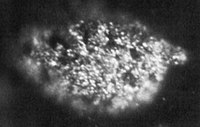
Photo from wikipedia
Abstract Investigation of microstructures and hardening property of initial irradiated, post-irradiation annealed, and re-irradiated Chinese-type low-Cu (0.01 wt%) reactor pressure vessel (RPV) steel were conducted by slow positron beam (SPB), TEM,… Click to show full abstract
Abstract Investigation of microstructures and hardening property of initial irradiated, post-irradiation annealed, and re-irradiated Chinese-type low-Cu (0.01 wt%) reactor pressure vessel (RPV) steel were conducted by slow positron beam (SPB), TEM, and nanoindentation. Results of the SPB measurements indicated that a large number density of open volume defects such as vacancies, vacancy clusters, vacancy-solute/H complexes, and dislocation loops were introduced in both initial-irradiated and re-irradiated specimens. The TEM results indicated that interstitial-type dislocation loops with a number density of ∼1022 m−3 were formed and the mean size (∼3 nm) of the dislocation loops was almost unchanged in both initial-irradiated and re-irradiated specimens. The open volume defects such as vacancy-type defects and dislocation loops were almost annealed out and some stable defects still existed in the post-irradiation annealed specimen. The nanoindentation results identified that the obvious hardening phenomena were found in the initial irradiated, post-irradiation annealed and re-irradiated specimens. The quantitative analysis suggested that irradiation hardening of Chinese-type low-Cu RPV steel were attributed to matrix defects including large-size vacancy clusters, vacancy-solute/H complexes, and dislocation loops produced during initial irradiation and re-irradiation. On the other hand, the existed stable defects such as solute-atom (Mn, Ni, and Si) complexes/precipitates, which cannot be distinguished by SPB or TEM, might be responsible for the rest fraction of irradiation hardening of highly initial irradiated and re-irradiated Chinese-type low-Cu RPV steel.
Journal Title: Journal of Nuclear Materials
Year Published: 2019
Link to full text (if available)
Share on Social Media: Sign Up to like & get
recommendations!